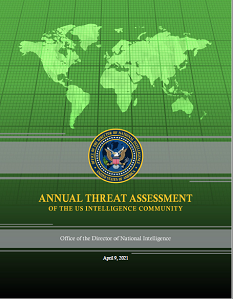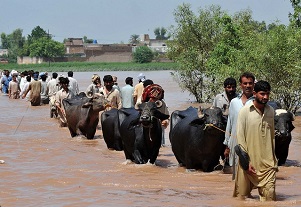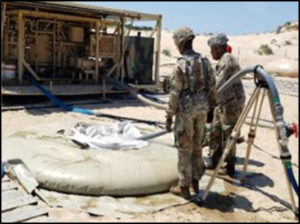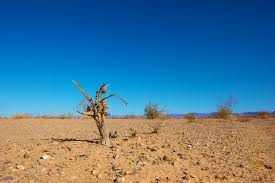[Editor’s Note: Climate Change and Environmental Degradation has been recognized as a Transnational Threat in the Office of the Director of National Intelligence‘s Annual Threat Assessment for the U.S. Intelligence Community —
“We assess that the effects of a changing climate and environmental degradation will create a mix of direct and indirect threats, including risks to the economy, heightened political volatility, human displacement, and new venues for geopolitical competition that will play out during the next decade and beyond.”
In keeping with the current administration’s renewed focus on climate change, Mad Scientist facilitated its Climate Change – Threats, Resilience, and Adaptation webinar on 13 April 2021 to continue exploring the impacts of climate change on the Operational Environment (OE). Today’s post captures what we have learned and the associated implications for the U.S. Army from this recent event, this Thursday’s upcoming podcast with Mr. Richard G. Kidd IV, Deputy Assistant Secretary of Defense for Environment and Energy Resilience at United States Department of Defense (see more about this, below), and previous blog posts — Read on!]
In order to effectively compete, deter aggression, and failing that, decisively defeat all potential adversaries in the OE, the U.S. Army will need to understand the deepening climate emergency and how it will impact U.S.  security in order to adapt accordingly. Climate change will influence migration, disease, installation security, and resource accessibility. Potential solutions to tackle this phenomenon, such as those found in the field of geoengineering, could also present an inherent threat if used for nefarious purposes. Thus, a robust understanding of the intersection of climate change and national security is essential for an effective and resilient Army.
security in order to adapt accordingly. Climate change will influence migration, disease, installation security, and resource accessibility. Potential solutions to tackle this phenomenon, such as those found in the field of geoengineering, could also present an inherent threat if used for nefarious purposes. Thus, a robust understanding of the intersection of climate change and national security is essential for an effective and resilient Army.
Insights on Climate Change and Migration
Per the NIC’s Global Trends 2040 – A More Contested World, “Continued pressure for global migration—as of 2020 more than 270 million persons were living in a country to which they have migrated, 100 million more than in 2000—will strain both origin and destination countries to manage the flow and effects.” Climate change will contribute to both temporary and permanent migration of vulnerable populations, particularly in regions with low government capacity. Mass migration will further burden destination resources and could induce new hotspots for conflict. The U.S. Army may be required to support and intervene in these areas, and thus the United States needs to both understand and prepare for this trend.
1. Climate change will join a list of many ‘push factors’ that will encourage migration. An increase in natural disasters as a result of climate change will increase the number of short-term refugees. However, it will be more difficult to discern an increase in permanent migration as a result of climate change. In many cases, climate change will both combine with, and contribute to, other migration incentives, such as economic and conflict factors. Thus, while climate change will certainly contribute to migration, it will be difficult to identify it as a sole reason for movement. Importantly, most migration occurs internally before it becomes international.

2. Migration itself could contribute to further environmental degradation, creating a vicious cycle between climate change and human migration. In the short term, migration is likely to increase resource scarcity in destinations, leading to increased pressure on both recipient governments and environments to support displaced populations. However, in the long term, international cooperation and technology development could ameliorate this consequence.
3. Government capacity to address climate change will be linked to climate migration. A government’s ability to adapt and support its citizens facing climate change challenges will be essential to managing climate migration. Should origin governments be unable to support their populations facing climate change, neighboring and destination governments will be further strained by an influx of climate migrants.
4. Migration as a result of climate change has become politicized globally, complicating international responses and cooperation on this issue. Data collection and analysis will be critical to addressing the threat of climate change, and to tackling migration crises it facilitates.

Implications for the Army: Climate change and mass migration are the conflict drivers of most concern, as we learned from Mad Scientist’s Global Perspectives in the Operational Environment Virtual Conference. Due to European geography and proximity to affected regions in northern Africa and the Middle East, climate change driven migration seemed to be of greater concern to our NATO partners than our focus on great power conflict. Indeed, mass migration events may threaten regional stability, undermine governments, and strain U.S. military and civilian responses. The Army will be increasingly called upon to provide humanitarian assistance, both abroad and in support of our own border security forces in handling increased migration from Central America and beyond, displaced by the effects of climate change. These operations will be conducted in an environment with the potential for increased heat casualties among our Soldiers and the need to transport water for use by the force and for humanitarian purposes. Consequently, the Army should continue to build resiliency across the force to mitigate the effects of climate change.
Insights on Climate Change and the Future of Disease
The COVID-19 pandemic has demonstrated that international response to airborne disease is insufficient. Climate change is likely to increase the rate at which airborne viruses are introduced to the global population. Implementing cost-effective prevention solutions will be essential to limiting the impact of disease outbreaks, which would otherwise distract from U.S. interests and Army missions. Many of these solutions, such as high filtration masks, already exist, and should be adopted and stockpiled to protect our Soldiers.
1. Climate change is likely to introduce new diseases, many of which  will be airborne. Climate change will force people into close contact with new diseases vectors, thaw viruses previously frozen in the permafrost in now melting regions, and increase population densities in urban centers where displaced populations often congregate, further facilitating the spread of disease.
will be airborne. Climate change will force people into close contact with new diseases vectors, thaw viruses previously frozen in the permafrost in now melting regions, and increase population densities in urban centers where displaced populations often congregate, further facilitating the spread of disease.
2. The “Aerosolized Internet,” a global network connecting people across the world via bio-aerosols transmitted by breathing, will continue to present a pandemic threat. When combined with an increase in disease as a result of climate change, the aerosolized internet will become an increasingly important element of global interconnectedness. Bad actors could attempt to harness the power of this network to create intentional pandemics.
3. Existing technology, such as specialty masks and air filtration systems, are cost-efficient solutions to addressing future airborne diseases. High filtration masks and HEPA filtration systems are already readily available and could help slow the spread of future disease if adopted. Such a solution would be analogous to installing anti-virus software on computers, and should be employed in military installations, government buildings, office spaces, and even homes.
Implications for the Army: COVID-19 sidelined the USS Theodore Roosevelt  (CVN 71) for almost two months in Guam, depriving its Carrier Strike Group, the Seventh Fleet, and Indo-Pacific Command of its considerable “Big Stick” deterrence and combat power in the western Pacific, and revealing our armed forces’ vulnerability to natural or weaponized novel pathogens. Our adversaries around the globe watched and learned that a considerable portion of the U.S.’s forward presence in that Combatant Command could be neutralized via exposure to a novel virus. To mitigate this potential
(CVN 71) for almost two months in Guam, depriving its Carrier Strike Group, the Seventh Fleet, and Indo-Pacific Command of its considerable “Big Stick” deterrence and combat power in the western Pacific, and revealing our armed forces’ vulnerability to natural or weaponized novel pathogens. Our adversaries around the globe watched and learned that a considerable portion of the U.S.’s forward presence in that Combatant Command could be neutralized via exposure to a novel virus. To mitigate this potential  threat vector, the Army and its Sister services should stockpile enough high filtration masks for all of its Warfighters and start to retroactively install HEPA filtration systems within all key military infrastructure.
threat vector, the Army and its Sister services should stockpile enough high filtration masks for all of its Warfighters and start to retroactively install HEPA filtration systems within all key military infrastructure.
Insights on Climate Change and Army Installations
Climate change will have a significant impact on military infrastructure, particularly the security of U.S. installations. Anticipated water stress, natural disasters, and changes in energy requirements of bases will necessitate early investment in mitigation strategies. While the Army is already adapting to this threat, the United States should continue to invest more in infrastructure modernization in order to mitigate the effects of climate change and ensure resiliency and future mission success.
1. Climate change will threaten Army installations. Increased frequency of natural disasters, changes in ground and soil consistency, stress on cooling systems, higher energy requirements, and reduced access to maneuver training areas and ranges will all affect Army readiness as climate change progresses.
2. Significant investment in and adaptation of Army installations will be necessary to sustain critical missions. Military installations will need to be adapted in the short term, despite budgetary constraints. The Army is currently addressing these conditions via Installation Energy and Water Plans (IEWP) to create a roadmap for improving systems at each installation.
3. Water stress will be a particularly challenging impact of climate change on military bases. Increased prevalence and duration of droughts throughout the United States will decrease the availability of water for Soldiers, training exercises, cooling systems, etc. Installations will need to develop innovative ways to conserve existing resources, reduce losses of water via advanced leak detection and repair, increase on-site storage, and explore new reclamation, rainwater, groundwater, and water treatment solutions.
 Implications for the Army: Climate change poses significant infrastructure and readiness issues for the U.S. Army. Increased incidences of wildfires and desertification limit the availability of land for training, potentially impacting units’ readiness and driving up programming requirements for the Army’s Sustainable Range Program (SRP) and the Integrated Training Area Management (ITAM) Program. Of the 21 Army installations assessed in the Report on Effects of a Changing Climate to the Department of Defense, 15 were subject to recurrent flooding, five were subject to drought, two were subject to desertification, four were subject to wildfires, and one was subject to thawing permafrost. The risk of wildfires has led to the conservative use of live fire training ranges, resulting in decreased weapons proficiency. Fires also threaten ranges and maneuver training areas that rely on both terrain and instrumentation to emulate battlefield conditions. The Army should begin planning mitigation measures now to offset the impact of climate change on its infrastructure in the coming years, as Military Construction (MILCON) should be programmed five years in advance of the year of execution. Installations that cannot be mitigated cost effectively may be considered candidates for future Base Realignment and Closure (BRAC) decisions.
Implications for the Army: Climate change poses significant infrastructure and readiness issues for the U.S. Army. Increased incidences of wildfires and desertification limit the availability of land for training, potentially impacting units’ readiness and driving up programming requirements for the Army’s Sustainable Range Program (SRP) and the Integrated Training Area Management (ITAM) Program. Of the 21 Army installations assessed in the Report on Effects of a Changing Climate to the Department of Defense, 15 were subject to recurrent flooding, five were subject to drought, two were subject to desertification, four were subject to wildfires, and one was subject to thawing permafrost. The risk of wildfires has led to the conservative use of live fire training ranges, resulting in decreased weapons proficiency. Fires also threaten ranges and maneuver training areas that rely on both terrain and instrumentation to emulate battlefield conditions. The Army should begin planning mitigation measures now to offset the impact of climate change on its infrastructure in the coming years, as Military Construction (MILCON) should be programmed five years in advance of the year of execution. Installations that cannot be mitigated cost effectively may be considered candidates for future Base Realignment and Closure (BRAC) decisions.
Insights on Climate Change and Geoengineering
It is in every nation’s core national interest to preserve and regenerate the natural environment. As a result, many countries are focused on developing novel ways to reverse the impact of climate change, such as geoengineering  (i.e., deliberately changing the environment through large-scale intervention in the climate system). However, such technologies present a dual use capability and are potentially dangerous and inherently difficult to test at-scale. As a result, they are of concern to national security themselves. The United States should proactively engage in international conversations regarding the use and regulation of these capabilities.
(i.e., deliberately changing the environment through large-scale intervention in the climate system). However, such technologies present a dual use capability and are potentially dangerous and inherently difficult to test at-scale. As a result, they are of concern to national security themselves. The United States should proactively engage in international conversations regarding the use and regulation of these capabilities.
1. Immediate adjustment in human behavior will be essential to avoid extreme future change in climate. Although climate change is inevitable, reduction in the use of fossil fuels can still be beneficial. International cooperation will be essential to this effort, given that the environment can be considered a common good. However, such collaboration may actually increase tensions internationally, given that more developed countries are largely responsible for the climate crisis, yet attempting to enforce more difficult standards of development on less developed countries.
2. Geoengineering has been identified as a potential mechanism to mitigate the impacts of climate change. Several methods of geoengineering are being explored by researchers, but problems scaling experimentation is limiting their adoption. This strategy will also be questioned under international law, as it deliberately changes a common good without certainty of positive impact.
3. Geoengineering practices will require significant regulation. Given their potential for great impact, misuse of geoengineering strategies could have dramatic consequences (i.e., the weaponization of weather). As a result, such technologies should be regulated internationally, perhaps in a manner similar to nuclear weapons.
 Implications for the Army: The United States Government and the Army should seek to understand the various ways in which geoengineering could be weaponized, in order to prepare for potential future threats of its use by our adversaries and to stand ready to convincingly refute false anti-American narratives promulgated by them that we are employing geoengineering unilaterally around the globe, exacerbating the effects of climate change on non-aligned nations.
Implications for the Army: The United States Government and the Army should seek to understand the various ways in which geoengineering could be weaponized, in order to prepare for potential future threats of its use by our adversaries and to stand ready to convincingly refute false anti-American narratives promulgated by them that we are employing geoengineering unilaterally around the globe, exacerbating the effects of climate change on non-aligned nations.
Conclusion
Climate change presents a clear and existential threat to global security. The U.S. Government and the Army need to prioritize immediate action to limit this threat, including infrastructure investment and adoption of cost-effective disease mitigation technology. Additional actions could include the Joint Requirements Oversight Council (JROC) taking into account the associated carbon footprints when considering required capability alternatives, and the Services exploring how to lower the carbon footprint associated with their legacy weapons systems. The United States also needs to engage globally on this issue in order to create proactive policies to address climate migration and geoengineering.
If you enjoyed this post, be sure to check out this Thursday’s (29 April 2021) The Convergence podcast — with Mr. Richard G. Kidd IV, Deputy Assistant Secretary of Defense for Environment and Energy Resilience at United States Department of Defense, addressing the climate change resiliency challenges and opportunities facing the Department of Defense, and the U.S. Army in particular…
… and peruse the following related content:
Mad Scientist’s Climate Change – Threats, Resilience, and Adaptation webinar guest panelists’ biographies and their slide decks here, and watch the entire video of the event here [access via a non-DoD network]
“The Heat is On” in “The Queue” Redux!
Climate Change as a Threat Multiplier, by LTCOL Nathan Pierpoint, Australian Army
Climate Change: Destroyer of World, by CPT Kyle Hallowell, U.S. Army
Climate Change Laid Bare: Why We Need To Act Now, by proclaimed Mad Scientist Sage Miller
Future Threats: Climate Change and Islamic Terror, by Matthew Ader
Water: A Fluid Challenge for the Future, by proclaimed Mad Scientist Caroline Duckworth
On Thin Ice…, by proclaimed Mad Scientist Seth Gnesin
Emergent Global Trends Impacting on the Future Operational Environment
 >>>REMINDER 1: Mad Scientist’s next virtual event — Through the Eyes of Gen Z: National Security Challenges and Solutions in the 21st Century — is this Thursday, 29 April 2021 (starting at 1300 EDT). Join us as we collaborate again with The College of William and Mary’s Project on International Peace and Security (PIPS) Program to broaden our aperture on the Operational Environment (OE). We will host two moderated discussion panels where PIPS Research fellows discuss the ramifications of their respective research topics on the OE and the changing character of competition, conflict, and U.S. strategy.
>>>REMINDER 1: Mad Scientist’s next virtual event — Through the Eyes of Gen Z: National Security Challenges and Solutions in the 21st Century — is this Thursday, 29 April 2021 (starting at 1300 EDT). Join us as we collaborate again with The College of William and Mary’s Project on International Peace and Security (PIPS) Program to broaden our aperture on the Operational Environment (OE). We will host two moderated discussion panels where PIPS Research fellows discuss the ramifications of their respective research topics on the OE and the changing character of competition, conflict, and U.S. strategy.
Check out the event flyer here, then register here now [via a non-DoD network] to participate in this informative event.
In the meantime, check out what we learned from last year’s event in GEN Z and the OE: 2020 Final Findings to whet your appetite for our upcoming event!
 >>>REMINDER 2: Young Minds on Competition and Conflict, the next webinar in our continuing series of Are We Doing Enough, Fast Enough? virtual events – explores our adversaries’ views on Competition, Crisis, Conflict, and Change on Thursday, 6 May 2021 (starting at 1000 EDT). Join our panel of prominent young minds from the national security arena as they share their ideas about the future of competition and conflict for the next decade. Register here now [via a non-DoD network] to participate in this informative event.
>>>REMINDER 2: Young Minds on Competition and Conflict, the next webinar in our continuing series of Are We Doing Enough, Fast Enough? virtual events – explores our adversaries’ views on Competition, Crisis, Conflict, and Change on Thursday, 6 May 2021 (starting at 1000 EDT). Join our panel of prominent young minds from the national security arena as they share their ideas about the future of competition and conflict for the next decade. Register here now [via a non-DoD network] to participate in this informative event.
Disclaimer: The views expressed in this blog post do not necessarily reflect those of the Department of Defense, Department of the Army, Army Futures Command (AFC), or Training and Doctrine Command (TRADOC).



